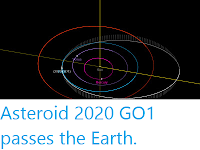Asteroid 2015 FC35 passed by the Earth at a distance of about 4 008 000
km (10.4 times the average distance between the Earth and the Moon, or 2.68% of the distance between the Earth and the Sun), slightly before 10.05 am
GMT on Saturday 4 April 2020. There was no danger of
the asteroid hitting us, though were it to do so it would have
presented a considerable threat. 2015 FC35 has an estimated
equivalent
diameter of 78-250 m (i.e. it is estimated that a spherical object with
the same volume would be 78-250 m in diameter), and an object at the upper end of this range would be predicted to be capable of passing
through the Earth's
atmosphere relatively intact, impacting the ground directly with an
explosion that would be 35 000 times as powerful as the
Hiroshima
bomb. Such an impact would result in an impact crater 3.8 km in
diameter
and devastation on a global scale, as well as climatic effects that
would last decades or even centuries.
2015 FC35 was discovered on 17 March 2015 by the University of Hawaii's PANSTARRS telescope. The
designation 2015 FC35 implies that it was the 843rd asteroid (asteroid C35 -
in numbering asteroids the letters A-Y, excluding I, are assigned
numbers from 1 to 24, with a number added to the end each time the
alphabet is ended, so that A = 1, A1 = 25, A2 = 49, etc., which means that C35 = 3 + (24 X 35) = 843)
discovered in the second half of March 2015 (period 2015 F).
2015 FC35 has a 600 day (1.64 year) orbital period, with an elliptical
orbit tilted at
an angle of 15.5° to the plain of the Solar System which takes in to
0.84 AU from the Sun (84% of the distance at which the Earth orbits the
Sun) and out to 1.94 AU (1.94% of the distance at which the Earth orbits
the sun and further from the Sun than the planet Mars).
This means that close
encounters between the asteroid and Earth are fairly common, with the
last thought to have happened in September 2015 and the next predicted
in March 2025. It is therefore classed as
an Apollo Group Asteroid (an asteroid that is on average further from the Sun
than the Earth, but which does get closer).
See also...
Follow Sciency Thoughts on Facebook.







